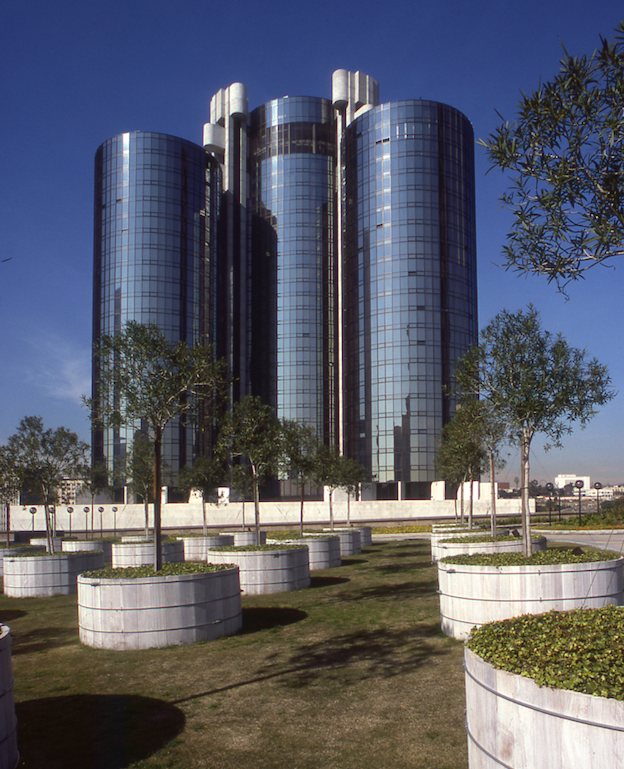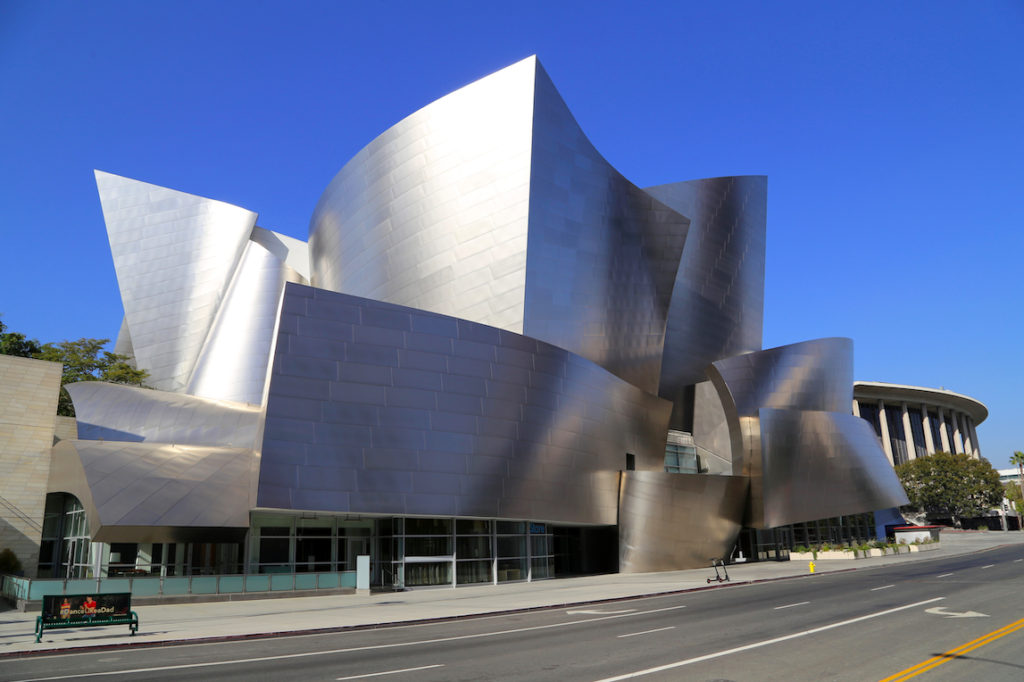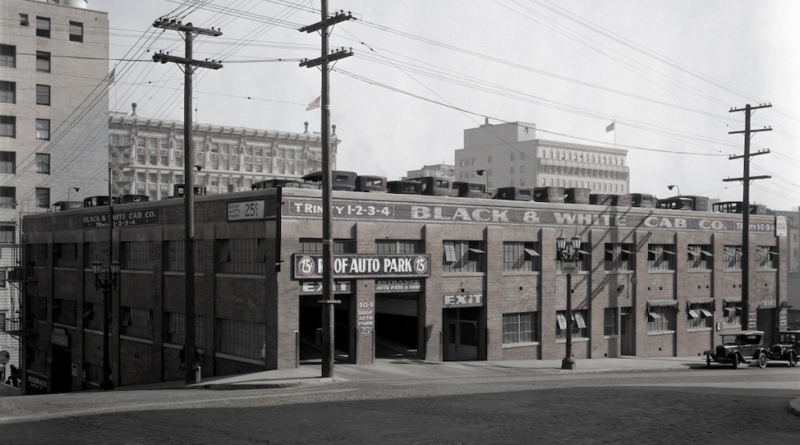INTERVIEW: Bunker Hill, Los Angeles, where ‘new’ eventually becomes ‘historic’
Photo: The Black & White Taxi / Savoy Auto Park on South Olive Street still stands to this day in Bunker Hill, Los Angeles. In 2023, the building celebrated its 100th anniversary. Photo courtesy of Nathan Marsak / Provided with permission.
Nathan Marsak has completed his trilogy of books about the endlessly interesting neighborhood of Bunker Hill, Los Angeles. His newest publication is called Marsak’s Guide to Bunker Hill, which serves as a handy guidebook for today’s Bunker Hill and the buildings that tower above these downtown blocks. Although Marsak’s previous publishing efforts focused on the neighborhood’s early Victorian architecture — a place populated by the likes of Raymond Chandler, John Fante and Leo Politi — this new book, featuring 65 pages in “bold color,” gives some respect and necessary space to the structures that came after redevelopment. The guidebook makes the case that terms like “old” and “new” are ultimately relative because the “new” part of Bunker Hill, which unfortunately took out the “old,” is now becoming worthy of preservation in its own right.
Marsak has been blogging about Bunker Hill and this “Museum of Modernism” for years, and his first book in this trilogy, titled Bunker Hill Los Angeles: Essence of Sunshine and Noir, is a coffee table exploration of how this predominantly residential neighborhood was built and what life was like in those Victorian residences before the city deemed them too rundown to save. That book finishes when the precious homes and apartment complexes fall under the mighty power of the cranes that came in and redeveloped the entire area some 50 years ago. His second book, Bunker Noir!, took a very Confidential-style look at the crimes and scandals that populate the neighborhood’s history.
Now, readers can jump into the final part, Marsak’s Guide to Bunker Hill, which begins with the oldest structures still standing, namely the Third Street Tunnel (1901) and the funky funicular known as Angels Flight (1901), and ends with the block’s newest residents, the Da Vinci Apartments (2016) and The Grand (2022). Using Marsak’s insights, one can walk around Bunker Hill and experience the history that’s currently standing and the history that’s only hinted at by some remnants of the past still intact.
“I wanted to have a map so that you could sort of walk around and look where you are on the map,” Marsak said in a recent phone interview, with only a few interruptions from his beloved cat lounging by his side. “Originally it was going to be a little walking tour … based on architectural style. I was like, no, no, I’m overthinking it. Do it chronologically, and then just have a map in it, and people will figure it out.”
Page by page, one can flip through the guidebook and discover the history of so many interesting buildings, even the ones that have their critics. On Page 26, there’s Union Bank Square (1967), while on Page 33, there’s the unmistakable Bonaventure Hotel (1976). The Subway Terminal Building (1925) is worthy of admiration, ditto for the Title Guarantee and Trust Building (1931).
“When we think of Bunker Hill, we think that it is all totally redeveloped, all post-war, all those sort of muscular 1980s, Reagan-era high-rises, but it actually has a lot of earlier stuff if you know where to look,” Marsak said. “Of course, there’s early stuff like Angels Flight and some of my very favorite structures, mostly on the southern end of the hill. You’ve got the old Savoy garage [Black & White Taxi / Savoy Auto Park (1923)], which … is our oldest, extant, standalone parking garage in Los Angeles, which probably doesn’t impress that many people. But when you think of how important parking garages and parking as a thing is to Los Angeles, that’s a huge monument there.”
Marsak even gives space to the Temple Street Grade Separation (1939), which he understands doesn’t generate the oohs and aahs that other architectural delights gather, but count him a fan. He believes the structure, an underpass project by Temple, Flower and Figueroa streets, is a solid piece of 1930s Public Works Administration architecture.
“By and large, the reason I wanted to write the book is because it just made my head spin walking around looking at all these modern, late modern, post-modern buildings, and I had no idea who the architects were for most of them,” he said. “Some of them are not very good, so to speak, but the history needs to be written on them because we’re a little too close to some of them to judge how good they are as examples of 1980s and 1990s architecture.”
In some ways, Marsak’s new book could be subtitled, “Come for the Victorian architecture, stay for the towers.” He understands the allure that a forgotten, mostly gone neighborhood brings to historians and history buffs. In fact, that’s what made him a fan of this corner of Los Angeles. He has spent many years learning the stories of Bunker Hill and collecting photographs and ephemera from the early to mid-20th century, but his is a yearning that wants to travel deeper and broader. He doesn’t want to simply disregard today’s “Hill” as a glass-and-concrete eyesore built on an architectural burial ground. The sights are still impressive if one opens themselves to the wonders of the many stories to be told.
“Obviously, like so many people, when you get interested in old Bunker Hill, you’re interested in the Victorian buildings,” he said. “People are commonly intrigued by the ramshackle Edwardian apartment houses and the dim alleyways you see in pictures. That’s the Bunker Hill everyone knows about. The [first] book I did on Bunker Hill is classic Bunker Hill, but the more time I spent there … the more I came to a begrudging respect for what was built.”
That respect includes everything from the County Courthouse (1958) to the Hall of Administration (1960), both of the late moderne style. He also appreciates the Forum Theatre / Mark Taper Forum (1967) and Center Theatre / Ahmanson Theatre (1967), both examples of New Formalist style by Welton Becket & Associates.

One can even walk the neighborhood with Marsak in person. He works part time as an operator on the world-famous Angels Flight railway, and he’ll be offering his expertise on a special tour with Esotouric this Saturday, Feb. 3. The experience, which finds Marsak walking alongside Esotouric’s Kim Cooper and Richard Schave, is called “Bunker Hill, Dead and Alive Walking Tour.”
“It started to intrigue me the later stuff, and that’s why I wanted to figure it out and write a guidebook,” Marsak said. “There were a lot of eponymous guidebooks when I was growing up. … Frommer’s guides were the ones that my parents used. They were named after Arthur Frommer, so I called it Marsak’s Guide. I thought, there you go, you see something like the Hotel Intercontinental, and you’ll be like, ‘I have no idea when that was built. I don’t know who designed it.’ Some of the structures are never going to be beloved, one must assume, but they are indicative of the time very much.”
Marsak added: “People make a lot of noise about the spiritual emptiness of those Reagan-era office towers, but those intrigue me, too. For my money, it’s really the whole collection of Kamnitzer Cotton projects on the hill that are both totally forgettable and yet burn themselves into your memory with their aggressive vacuity. … There’s some pathos in getting to know what are these recent buildings, who designed them, and then you’ll get a feeling for why parts of the hill are so strange and unloved.”
Perhaps the most prominent peculiarity is that Black & White Taxi / Savoy Auto Park. The Victorian houses and apartment complexes of yesteryear are long gone, with only the slightest hints that they were even there in the first place. For example, the Fremont Hotel still has its retaining wall intact on South Olive Street, but that’s about it. Somehow, this auto park survived the redevelopment years and celebrated its 100th anniversary in 2023. Marsak has an idea why this simple structure has made it into the 21st century: This is Los Angeles, after all, and parking is key.
“That was the parking garage area of Bunker Hill,” Marsak said of South Olive Street. “Because it’s sort of nestled into the L-shaped crook of the Subway Terminal Building, which is a magnificent and important structure by Schultze & Weaver, nobody ever thought to tear it down, which makes me happy. I will not be surprised if it becomes a preservation concern and they want to put a tower there, much in the way the Biltmore, for example, had a little theater attached to it. And they tore that down and put a tower there. Here’s the thing that’s crazy about this modern post-war Bunker Hill: After having come to this begrudging respect for the modern structures, I never would have thought that there would now be preservation issues for post-war Bunker Hill.”
He added: “It’s really interesting that we lament the loss of old Bunker Hill having been replaced by all these new modern towers, but now we have to worry about all these modern towers, which a lot of them are approaching 50-60 years old. They’re garnering historic status. I still think of the ‘70s as being 10 years ago, which sort of shows my age, but now these things are ancient and historic. And thankfully people can still go into a lot of amazing, untouched lobbies. The Security Pacific Bank lobby is amazing. It looks like it’s totally out of 1974.”
But one building, above all the rest, commands Marsak’s attention. So here’s an insider’s recommendation: “If I had to choose one structure on Bunker Hill that every Angeleno and tourist should go to it would, of course, be inside the Bonaventure Hotel. It’s so completely wacky and insane and post-modern and has been in so many movies. The revolving bar, BonaVista Lounge, on top of the Bonaventure, was closed for years because they couldn’t figure out how to make it revolve anymore. It just started revolving again. It’s the best view of L.A. anywhere, so I always tell people who ride up Angels Flight to go and have some drinks at the revolving bar in the Bonaventure Hotel.”
There’s a good chance Marsak will be sitting there, taking in the view as well.
By John Soltes / Publisher / John@HollywoodSoapbox.com
Marsak’s Guide to Bunker Hill by Nathan Marsak is now available. His previous books include Bunker Hill Los Angeles: Essence of Sunshine and Noir and Bunker Noir! Click here for more information.


